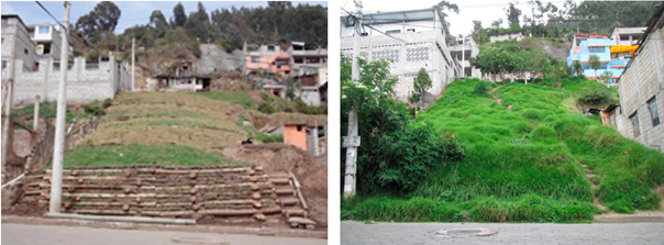Supporting factors and barriers for the transferability of Soil and Water Bioengineering (SWBE) applications in Central and South America

A new study conducted by the Department of Agriculture, Food, Environment, and Forestry (DAGRI) in Italy (partner in PlaNet network) has been published on the journal “Sustainability”.
The work describes a transferability analysis of Soil and Water Bioengineering (SWBE) applications in Central and South America as sustainable solutions for erosion control, stabilization and consolidation along slopes and banks.
31 case studies located in Mexico, Nicaragua, Guatemala, Colombia, Ecuador and Brazil have been analysed, where SWBE have been implemented, for which it was assessed the transferability potential, namely the potential to transfer and apply these measures from one context to another, to demonstrate the external validity of the concept, independently from situation or time.

Example of Soil-Bioengineering construction in San Luis de Chillogallo in Quito, assessed in the study.
Methodology
The transferability analysis was applied to the case studies and consisted in different steps: objectives, impact of the measure, potential up-scaling/downscaling needs, main phases (planning, construction, use phase, end of life) and their components (know-how, materials, qualified labour, monitoring, replicability, among others), identification of the level of importance of each component in the context of a take-up site (a context where to apply the same measures). Assessing the components of each phase allowed to determine key barriers, as well as key support factors for the transferability of SWBE.
Main results
Supporting key factors
Supporting aspects for the transfer of the SWBE solutions were materials (availability and costs), monitoring, sustainability, maintenance and applicability. The most important key factors of success were assessed to be appropriateness, sustainability and cost-effectiveness of these techniques and bio-technical issues, as various plant species with important characteristics for soil and water bioengineering are available as native or introduced species in Central and South America.
Barriers and how to overcome them
The barriers for the application of SWBE measures appeared to be the qualified labour (as not all of the people involved in the implementation of SWBE have the proper training), equipment/mechanical instruments (i.e. limited site access to heavy equipment in rural areas), hydraulics, know-how in SWBE and pedology, as they all have shown high importance but modest constraints for the transfer.
To overcome the barriers these are some of the actions proposed: i) increase the number of workshops or seminars held by experts to educate and create qualified labor regarding SWBE, ii) to support the participatory process within construction projects to help to spread knowledge on SWBE; iii) to adopt massive types of SWBE to tackle with extreme rainfall events and higher groundwater levels.
Source
The work has been published as part of the Special Issue “Sustainable Use of Nature-Based Solutions for Erosion Control and Slope Protection” and is available online:
Abstract: https://www.mdpi.com/2071-1050/12/24/10505
PDF Version: sustainability-12-10505-v3.pdf
Contact person: prof. Federico Preti (UNIFI)
Additional links: from University of Florence https://www.ateneosostenibile.unifi.it/art-199-ingegneria-naturalistica.html